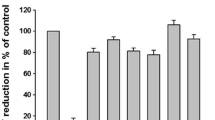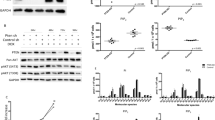Abstract
The relationship between plasma levels of total phospholipids (PL) and/or PL fractions and neoplastic diseases are not fully understood. Therefore, the aim of this study was to analyze concentrations and distribution of plasma phospholipids in patients with prostate cancer (PCa) related to the Gleason score, clinical stage and pathologic grade of prostate cancer. We analyzed plasma phospholipids in 57 newly diagnosed, untreated PCa patients and in 43 age-matched healthy male subjects. Significantly lower (P < 0.01) levels of total plasma PL and all PL classes were found in PCa patients when compared with healthy subjects. The relative concentrations of PL fractions were also changed. Further decrease of total PL and PL fractions was found related to an increase of clinical stadium, pathologic grade, and Gleason score, with phosphatidylethanolamine as the most sensitive plasma PL, the level of which significantly decreased even at the first stage of PCa. Our results showed an altered plasma PL profile in PCa patients, which may contribute to monitoring of the disease progression.
Similar content being viewed by others
References
Wright MM, Howe AG, Zaremberg V. Cell membranes and apoptosis: role of cardiolipin, phosphatidylcholine, and anticancer lipid analogues. Biochem Cell Biol. 2004;82(1):18–26.
Wolf C, Quinn PJ. Lipidomics: practical aspects and applications. Prog Lipid Res. 2008;47(1):15–36.
Spector AA, Yorek MA. Membrane lipid composition and cellular function. J Lipid Res. 1985;26:1015–35.
Tepsic J, Vucic V, Arsic A, Blazencic-Mladenovic V, Mazic S, Glibetic M. Plasma and erythrocyte phospholipid fatty acid profile in professional basketball and football players. Eur J Appl Physiol. 2009;107(3):359–65.
Kim H, Min HK, Kong G, Moon MH. Quantitative analysis of phosphatidylcholines and phosphatidylethanolamines in urine of patients with breast cancer by nanoflow liquid chromatography/tandem mass spectrometry. Anal Bioanal Chem. 2009;393(6–7):1649–56.
Min HK, Kong G, Moon MH. Quantitative analysis of urinary phospholipids found in patients with breast cancer by nanoflow liquid chromatography-tandem mass spectrometry: II. Negative ion mode analysis of four phospholipid classes. Anal Bioanal Chem. 2010;396(3):1273–80.
Preetha A, Banerjee R, Huilgol N. Surface activity, lipid profiles and their implications in cervical cancer. J Cancer Res Ther. 2005;1(3):180–6.
Cvetkovic Z, Cvetkovic B, Petrovic M, et al. Lipid profile as a prognostic factor in cancer patients. J BUON. 2009;14(3):501–6.
Sullentrop F, Moka D, Neubauer S, et al. 31P NMR spectroscopy of blood plasma: determination and quantification of phospholipid classes in patients with renal cell carcinoma. NMR Biomed. 2002;15(1):60–8.
Taylor LA, Arends J, Hodina AK, Unger C, Massing U. Plasma lyso-phosphatidylcholine concentration is decreased in cancer patients with weight loss and activated inflammatory status. Lipids Health Dis. 2007;6:17.
Kuliszkiewicz-Janus M, Janus W, Baczynski S. Application of 31P NMR spectroscopy in clinical analysis of changes of serum phospholipids in leukemia, lymphoma and some other non-haematological cancers. Anticancer Res. 1996;161(3B):1587–94.
Raffelt K, Moka D, Sullentrop F, Dietlein M, Hahn J, Schicha H. Systemic alterations in phospholipid concentrations of blood plasma in patients with thyroid carcinoma: an in vitro (31)P high-resolution NMR study. NMR Biomed. 2000;13(1):8–13.
Grubb RL 3rd, Kibel AS. Prostate cancer: screening, diagnosis and management in 2007. Mo Med. 2007;104(5):408–13. quiz 413–414.
Vucic V, Niciforovic A, Adzic M, Radojcic MB, Ruzdijic S. The combination of gamma ionizing radiation and 8-Cl-cAMP induces synergistic cell growth inhibition and induction of apoptosis in human prostate cancer cells. Invest New Drugs. 2008;26(4):309–17.
Tosoian J, Loeb S. PSA and beyond: the past, present, and future of investigative biomarkers for prostate cancer. ScientificWorldJournal. 2010;10:1919–31.
Rubin MA, Bismar TA, Curtis S, Montie JE. Prostate needle biopsy reporting: how are the surgical members of the Society of Urologic Oncology using pathology reports to guide treatment of prostate cancer patients? Am J Surg Pathol. 2004;28(7):946–52.
Stamey TA, Kabalin JN, Ferrari M, Yang N. Prostate specific antigen in the diagnosis and treatment of adenocarcinoma of the prostate. IV. Anti-androgen treated patients. J Urol. 1989;141(5):1088–90.
Gleason DF, Mellinger GT. Prediction of prognosis for prostatic adenocarcinoma by combined histological grading and clinical staging. J Urol. 1974;111(1):58–64.
American Joint Committee on Cancer (AJCC), et al. Prostate. In: Greene FL, Pge DL, Fleming ID, Fritz AG, Balch CM, editors. AJCC cancer staging manual, vol. 6. New York (NY): Springer; 2002. p. 309–16.
Marinovic V, Nedic O, Stanojevic N, Baricevic I, Pavlica S. Investigation of the relationship between two major prostate tumour markers. Yugoslav Med Biochem. 2000;19(4):407–10.
Zilversmit DB, Davis AK. Microdetermination of plasma phospholipids by trichloroacetic acid precipitation. J Lab Clin Med. 1950;35(1):155–60.
Ristic V, Tepsic V, Ristic-Medic D, et al. Plasma and erythrocyte phospholipid fatty acids composition in Serbian hemodialyzed patients. Ren Fail. 2006;28(3):211–6.
Marinetti GV, Albrecht M, Ford T, Stotz E. Analysis of human plasma phosphatides by paper chromatography. Biochim Biophys Acta. 1959;36:4–13.
Khuu Thi-Dinh KL, Demarne Y, Nicolas C, Lhuillery C. Effect of dietary fat on phospholipid class distribution and fatty acid composition in rat fat cell plasma membrane. Lipids. 1990;25(5):278–83.
Zeghari N, Younsi M, Meyer L, Donner M, Drouin P, Ziegler O. Adipocyte and erythrocyte plasma membrane phospholipid composition and hyperinsulinemia: a study in nondiabetic and diabetic obese women. Int J Obes Relat Metab Disord. 2000;24(12):1600–7.
Ackerstaff E, Pflug BR, Nelson JB, Bhujwalla ZM. Detection of increased choline compounds with proton nuclear magnetic resonance spectroscopy subsequent to malignant transformation of human prostatic epithelial cells. Cancer Res. 2001;61(9):3599–603.
Kuliszkiewicz-Janus M, Baczynski S. Application of 31P NMR spectroscopy to monitor chemotherapy-associated changes of serum phospholipids in patients with malignant lymphomas. Magn Reson Med. 1996;35(4):449–56.
Kuliszkiewicz-Janus M, Baczynski S. Treatment-induced changes in 31P-MRS (magnetic resonance spectroscopy) spectra of sera from patients with acute leukemia. Biochim Biophys Acta. 1997;1360(1):71–83.
Cvetkovic Z, Vucic V, Cvetkovic B, et al. Abnormal fatty acid distribution of the serum phospholipids of patients with non-Hodgkin lymphoma. Ann Hematol. 2010;89(8):775–82.
Murphy RA, Wilke MS, Perrine M, et al. Loss of adipose tissue and plasma phospholipids: relationship to survival in advanced cancer patients. Clin Nutr. 2010;29(4):482–7.
Marra CA, de Alaniz MJ. Regulatory effect of various steroid hormones on the incorporation and metabolism of [14C]stearate in rat hepatoma cells in culture. Mol Cell Biochem. 1995;145(1):1–9.
Koo JM, Shim BS. Significance of Serum Testosterone for Prostate-Specific Antigen (PSA) Elevation and Prediction of Prostate Cancer in Patients with PSA Above 10 ng/ml. Korean J Urol. 2010;51(12):831–5.
Morote J, Planas J, Ramirez C, et al. Evaluation of the serum testosterone to prostate-specific antigen ratio as a predictor of prostate cancer risk. BJU Int. 2010;105(4):481–4.
Zhao Z, Xiao Y, Elson P, et al. Plasma lysophosphatidylcholine levels: potential biomarkers for colorectal cancer. J Clin Oncol. 2007;25(19):2696–701.
Acknowledgments
This work was supported by the Project 41030 financed by the Ministry of Science of the Republic of Serbia.
Conflict of interests
The authors declare that they have no competing interests.
Author information
Authors and Affiliations
Corresponding author
Rights and permissions
About this article
Cite this article
Cvetković, B., Vučić, V., Cvetković, Z. et al. Systemic alterations in concentrations and distribution of plasma phospholipids in prostate cancer patients. Med Oncol 29, 809–814 (2012). https://doi.org/10.1007/s12032-011-9914-z
Received:
Accepted:
Published:
Issue Date:
DOI: https://doi.org/10.1007/s12032-011-9914-z




